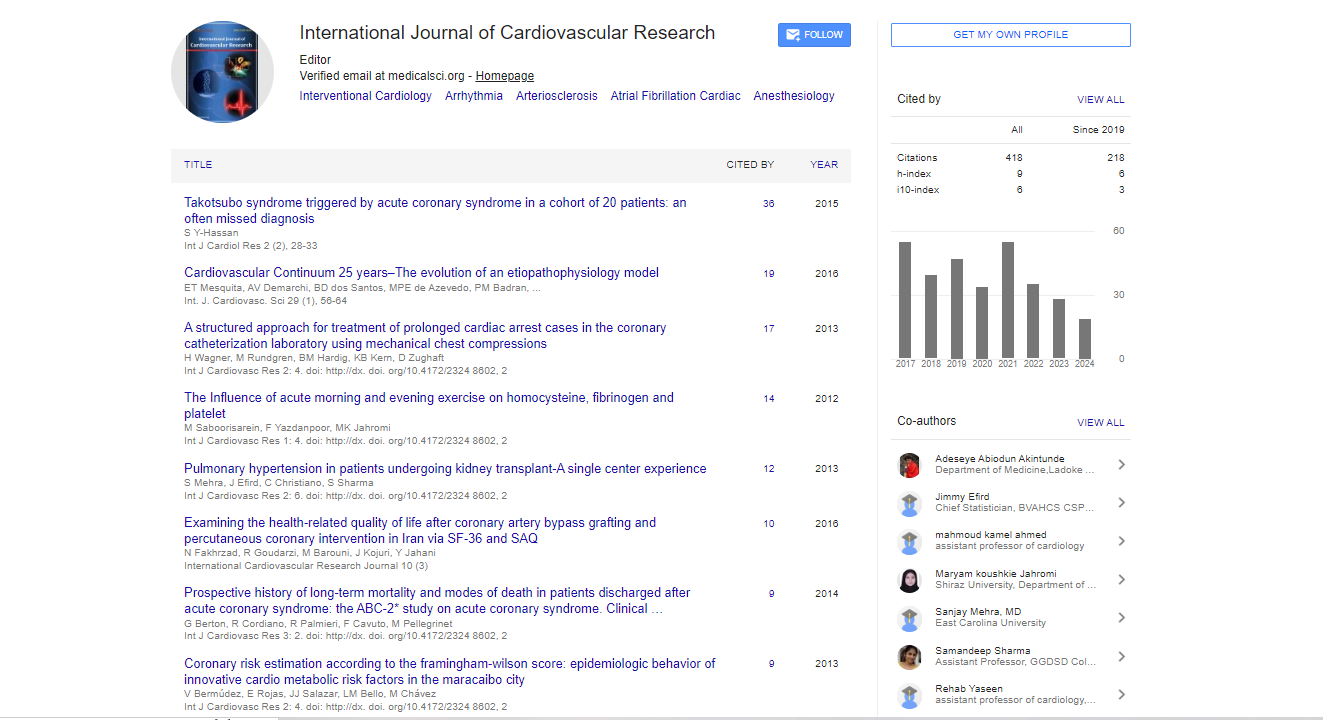Opinion Article, Int J Cardiol Res Vol: 13 Issue: 3
Bradycardia: Diagnostic Pathways and Therapeutic Strategies for Effective Management
Kelsey Aida*
1Department of Medicine, University of Florida, Florida, United States of America
*Corresponding Author: Kelsey Aida,
Department of Medicine, University of
Florida, Florida, United States of America
E-mail: aida.k@medicine.ufl.edu
Received date: 27 May, 2024, Manuscript No. ICRJ-24-144345;
Editor assigned date: 30 May, 2024, PreQC No. ICRJ-24-144345 (PQ);
Reviewed date: 13 June, 2024, QC No. ICRJ-24-144345;
Revised date: 21 June, 2024, Manuscript No. ICRJ-24-144345 (R);
Published date: 28 June, 2024, DOI: 10.4172/2324-8602.1000564
Citation: Aida K (2024) Bradycardia: Diagnostic Pathways and Therapeutic Strategies for Effective Management. Int J Cardiol Res 13:3.
Description
Bradycardia, characterized by an abnormally slow heart rate, is a clinical condition with significant implications for cardiovascular health. Defined as a resting heart rate of fewer than 60 beats per minute in adults, bradycardia can arise from a variety of causes, ranging from benign physiological adaptations to serious underlying pathologies. The heart's rhythm is regulated by the Sinoatrial (SA) node, located in the right atrium, which generates electrical impulses that initiate each heartbeat. These impulses travel through the Atrioventricular (AV) node and the his-purkinje system to stimulate ventricular contraction. Bradycardia occurs when there is a disruption in this electrical conduction system, leading to a slower-than-normal heart rate. Bradycardia can be categorized into several types based on its underlying cause and the location of the conduction disturbance. Sinus bradycardia originates in the SA node, where the rate of impulse generation is reduced. Sinus bradycardia can be a normal physiological response in athletes, who often have lower resting heart rates due to enhanced vagal tone and increased cardiac efficiency. It can also occur in response to conditions such as hypothyroidism or drug effects.
Heart block refers to a delay or complete block in the conduction system between the atria and ventricles. It is classified into three degrees: First degree heart block is characterized by a prolonged PR interval on the Electrocardiogram (ECG), indicating delayed conduction through the AV node. Second degree heart block includes Type I (Wenckebach) and Type II (Mobitz) blocks. Type I is marked by progressively prolonged PR intervals until a beat is dropped, while Type II involves intermittent failure of conduction without preceding PR interval changes. Third degree heart block is also known as complete heart block, it involves a complete dissociation between atrial and ventricular activity, leading to a slower escape rhythm from the ventricles. Sick sinus syndrome involves malfunction of the SA node, leading to abnormal heart rhythms, including bradycardia. It often presents with intermittent periods of bradycardia, tachycardia or both. Some patients with idiopathic cardiomyopathy may experience bradycardia due to impaired myocardial function affecting the electrical conduction system.
The clinical manifestations of bradycardia can vary widely depending on the rate of the heartbeat, the underlying cause and the individual's overall health. A slower heart rate can reduce cardiac output, leading to decreased perfusion of vital organs and causing fatigue or weakness. Reduced blood flow to the brain can result in dizziness particularly during sudden changes in posture or exertion. Bradycardia may impair the heart's ability to meet the body's oxygen demands, leading to shortness of breath, particularly during physical activity. Some individuals may experience chest discomfort due to insufficient coronary perfusion.
The diagnosis of bradycardia involves a combination of clinical assessment and diagnostic testing. The primary tool for diagnosing bradycardia, an ECG provides detailed information about the heart's electrical activity. It helps identify the type of bradycardia, such as sinus bradycardia or heart block and provides insights into the severity and potential causes. This ambulatory ECG monitoring technique records the heart's electrical activity over 24 to 48 h, capturing intermittent bradycardia episodes that may not be evident on a standard ECG. Similar to Holter monitoring but used for longer periods, event monitors record the heart's activity during symptomatic episodes, aiding in the diagnosis of bradycardia related to transient conditions. In some cases, an invasive electrophysiological study may be performed to evaluate the heart's electrical conduction system and determine the appropriate treatment.
In asymptomatic individuals with sinus bradycardia, especially athletes, no specific treatment may be necessary. Regular monitoring and periodic assessments are typically sufficient. For bradycardia caused by medication or certain conditions, adjusting the dosage or switching to alternative medications may alleviate symptoms. For example, reducing the dose of betablockers or discontinuing certain drugs can resolve drug-induced bradycardia. In cases of symptomatic bradycardia, particularly with significant heart block or sick sinus syndrome, a pacemaker may be indicated. This device provides electrical stimulation to maintain an adequate heart rate and ensure proper cardiac function. Addressing the root cause of bradycardia, such as managing thyroid disorders or treating infections, can resolve the bradycardic episodes and improve overall cardiac health.
Conclusion
Bradycardia, though often benign, can signal underlying cardiac or systemic issues requiring careful evaluation and management. Understanding its etiology, manifestations and diagnostic approach is important for effective treatment and improved patient outcomes. With advancements in diagnostic techniques and therapeutic options, the management of bradycardia continues to provide increased care for individuals affected by this condition.
 Spanish
Spanish  Chinese
Chinese  Russian
Russian  German
German  French
French  Japanese
Japanese  Portuguese
Portuguese  Hindi
Hindi 



